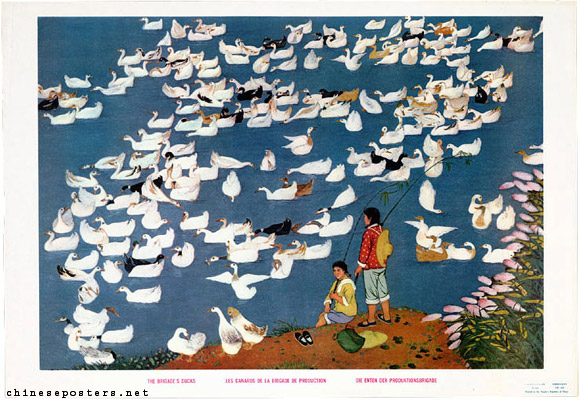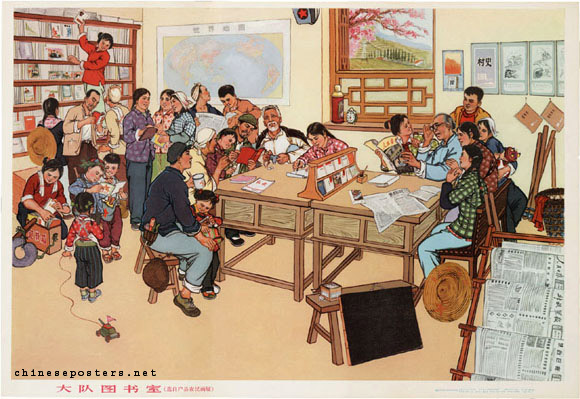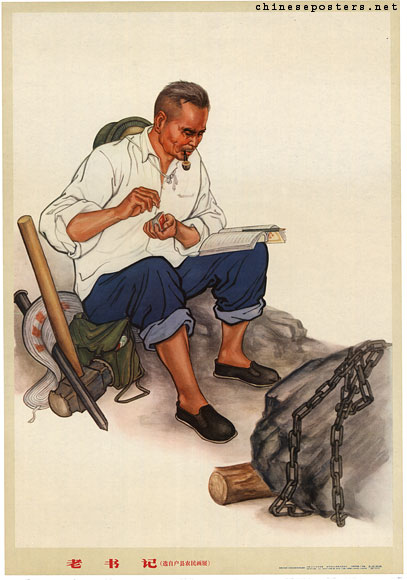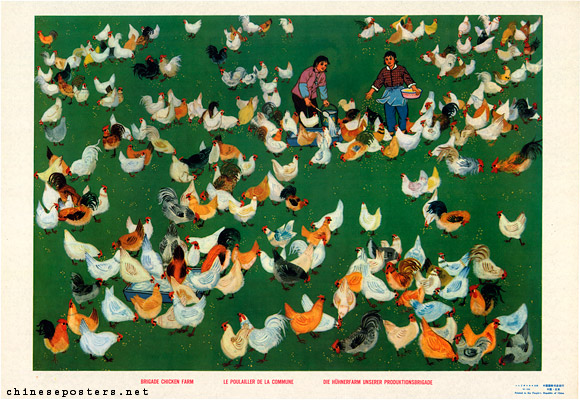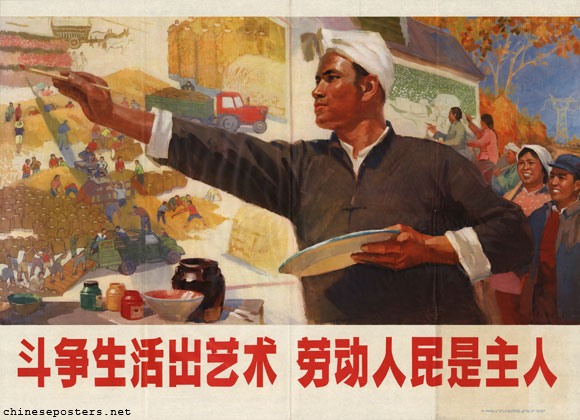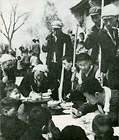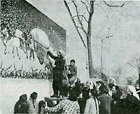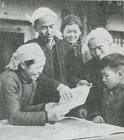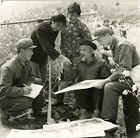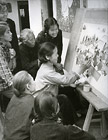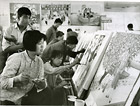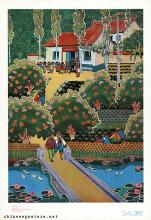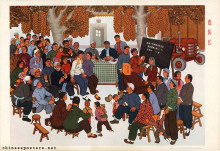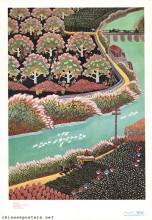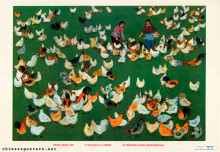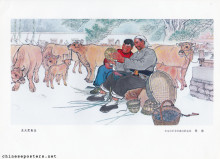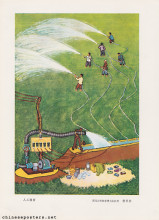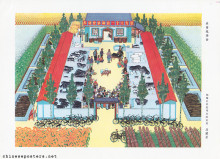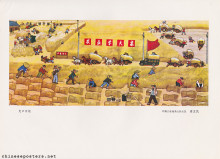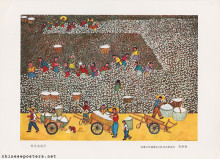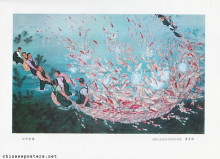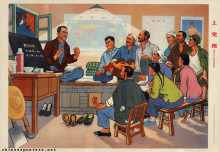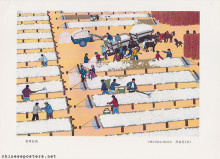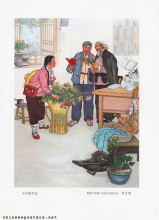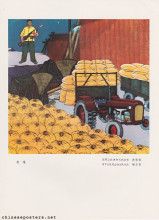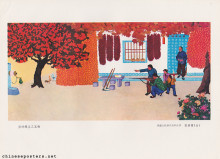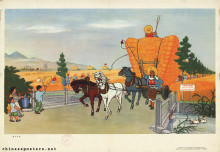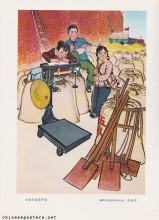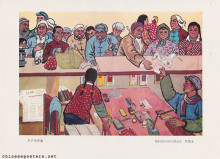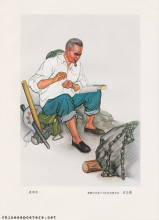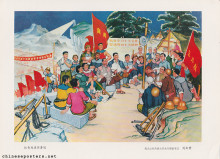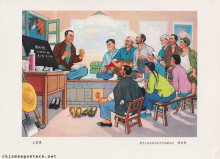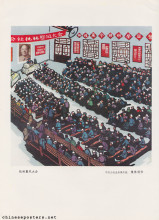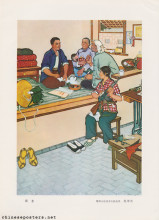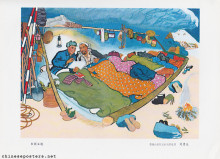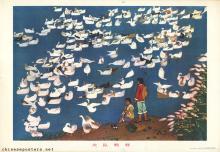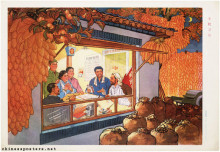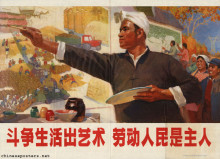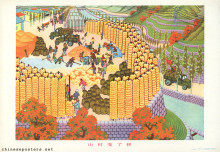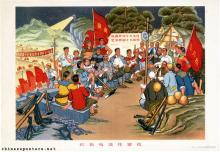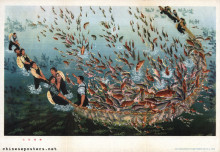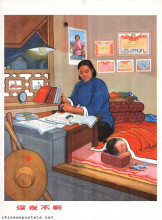Li Zhenhua, The brigade's ducks, 1973
In the second half of the Cultural Revolution (early 1970s), the works of amateur artists among workers and peasants were given nation-wide attention and support. These amateurs were promoted as representatives of the innate creative genius of the masses, as living proof that everyone could and should practice art. As such, they became eminently emulatable models. The most well-known were the workers from Shanghai, Yangquan and Lüda, who mounted a successful exhibition in Beijing in 1974; and the peasant painters from Huxian (户县, presently a district of Xian and called Huyi District - 鄠邑区), Shaanxi Province. The latter even became internationally acclaimed for their naive, colorful style in painting when they were given the opportunity to exhibit their work in Paris in 1975.
Dong Zhengyi, The commune's fishpond, 1973
Although touted as amateurs, it was later admitted that the peasant painters had received extensive professional help and assistance in "the composition of their pictures, as well as with the conception, presentation and skillful rendering" in their work. The advice and assistance was often provided by precisely those professional artists who were no longer allowed to work themselves. The professional influences are particularly evident when one compares 'Huxian art' created during the Cultural Revolution with the examples of their work from the late 1950s and early 1960s. The flat, single-dimensional figures of the early paintings were replaced with more three-dimensional figures, and the later works testify to a greater use of perspective.
Zhao Kunhan, The production brigade's reading room, 1974
The Huxian painters excelled in the portrayal of local and national heroes and deep-space landscapes for propaganda purposes; and a strong geometric organisation and repeated patterns, for decorative purposes. Their highly political paintings provided idyllic slices of the good life in the rural areas, and were peopled with happy and enthusiastic peasants engaged in agriculture, political meetings and study sessions.
Liu Zhigui, After the bumper harvest, 1974
Various books and journals that supplied information on how to represent human beings, agricultural machinery, and others, were published in the early 1970s. Without doubt, these publications functioned as sources of inspiration for the amateur artists. They contained concise close-ups of workers, peasants and soldiers, young or old, male or female, at work or engaged in some other meaningful activity, sometimes from posters that had already been published, and were intended to provide good examples of how to represent human beings in art. In all probability, these source-books were responsible for the stereotyped and standardised quality of the propaganda posters published in this period.
Liu Zhide, Old party secretary, 1975
Among the better known Huxian Peasant Painters are Bai Tianxue, Li Fenglan, Liu Zhide and Liu Zhigui.
'Peasant Art' in Huxian did not start or end with the Cultural Revolution. In 1958, professional artists were sent to Huxian and many other provinces to train peasants in making of wall paintings in praise of the Great Leap Forward. Around 1963, peasant painters were playing an important role in the Socialist Education Movement in Huxian. In 1966, the Huxian peasant painters already were promoted nation-wide for a brief time. After 1976, Huxian peasant painters contributed to the campaign against the Gang of Four. Gradually, the focus shifted away from policital themes to more decorative, stylized 'folk art', produced for the private market, both national and international.
Ma Yali, Brigade chicken Farm, 1973
Wang Weixin, Wang Liguo, A life of combat produces art, the working people are in charge, 1974
Here are some propaganda photographs from the years 1974-1977, featuring 'amateur artists' among workers, soldiers and peasants.
Dean Ashton, "Huxian's Foolish Old Men Create New Scenes: Huxian Peasant Paintings from the Cultural Revolution and their Ideological Discourses", The Arbutus Review 1 (2010), 44-66
Jutta Bewig, Bauernmalerei aus Huxian [Peasant Paintings from Huxian] (Frankfurt/M: Gesellschaft für Deutsch-Chinesische Freundschaft, 1979)
Ralph Croizier, "Hu Xian Peasant Painting: From Revolutionary Icon to Market Commodity", in Richard King (ed.), Art in Turmoil. The Chinese Cultural Revolution, 1966-76 (Vancouver: UBC Press, 2010)
Li Fenglan, "How I Began to Paint the Countryside", China Reconstructs, January 1974, 21-23
Fine Arts Collection Section of the Cultural Group Under the State Council of the People's Republic of China (eds.), Peasant Paintings from Huhsien County (Peking: People's Fine Arts Publishing House 1976)
Stewart E. Fraser, (ed.), 100 Great Chinese Posters: Recent Examples of "the People's Art" from the People's Republic of China (New York: Images Graphiques, Inc. 1977)
Maria Galikowski, Arts and Politics in China, 1949-1984 (Hong Kong: The Chinese University Press 1998)
Ellen Johnston Laing, "Chinese Peasant Painting, 1958-1976: Amateur and Professional", Art International 27:1 (1984), 1-12
"Luta's Worker-Artists", China Reconstructs, August 1973, 29-31
Peasant Paintings from Hu County, Shensi Province, China (London: Arts Council, 1976)
Peasant Paintings from Huhsien County (Peking: People's Fine Arts Publishing House, 1976), s.p.
- "Peasant Paintings from Huhsien County - Foreword"
Peasant paintings from Huhsien County of the People's Republic of China (Los Angeles : US-China Peoples Friendship Association, 1977).
"Peasant Painters of Huhsien", China Reconstructs, January 1974, 17-20
Guowuyuan wenhuazu meishu zuopin zhengji xiaozu (eds.), Shanghai, Yangquan, Lüda gongrenhua zhanlan zuopin xuanji [Selection of Works from the Exhibition of Workers' Art from Shanghai, Yangquan and Lüda] (Beijing: Renmin meishu chubanshe, 1975)
Shen Weilong (申威隆), "Huxian: Peasant Painting Museum" (户县:农民画博物馆), www.sohu.com, 26 June 2018
